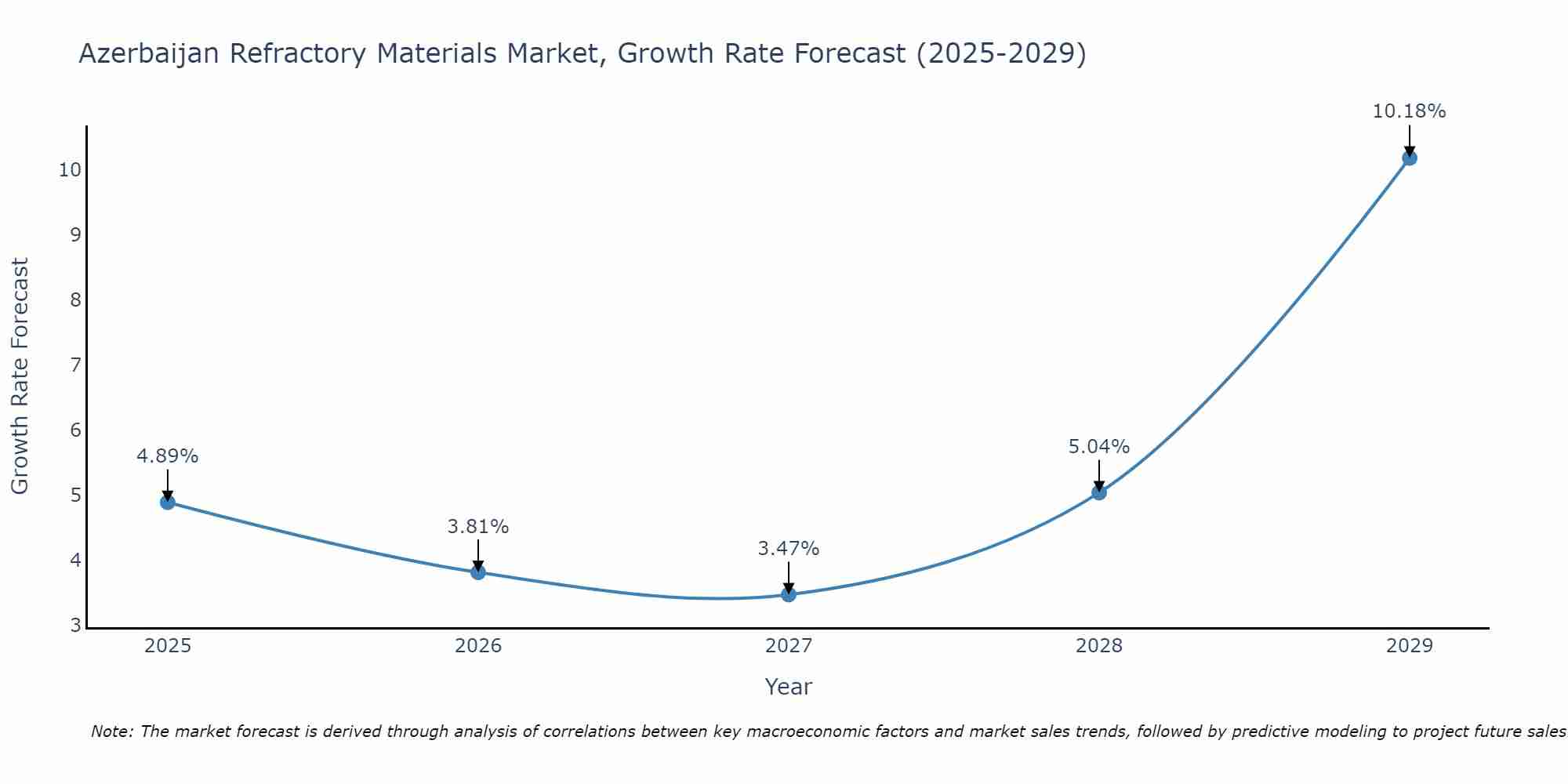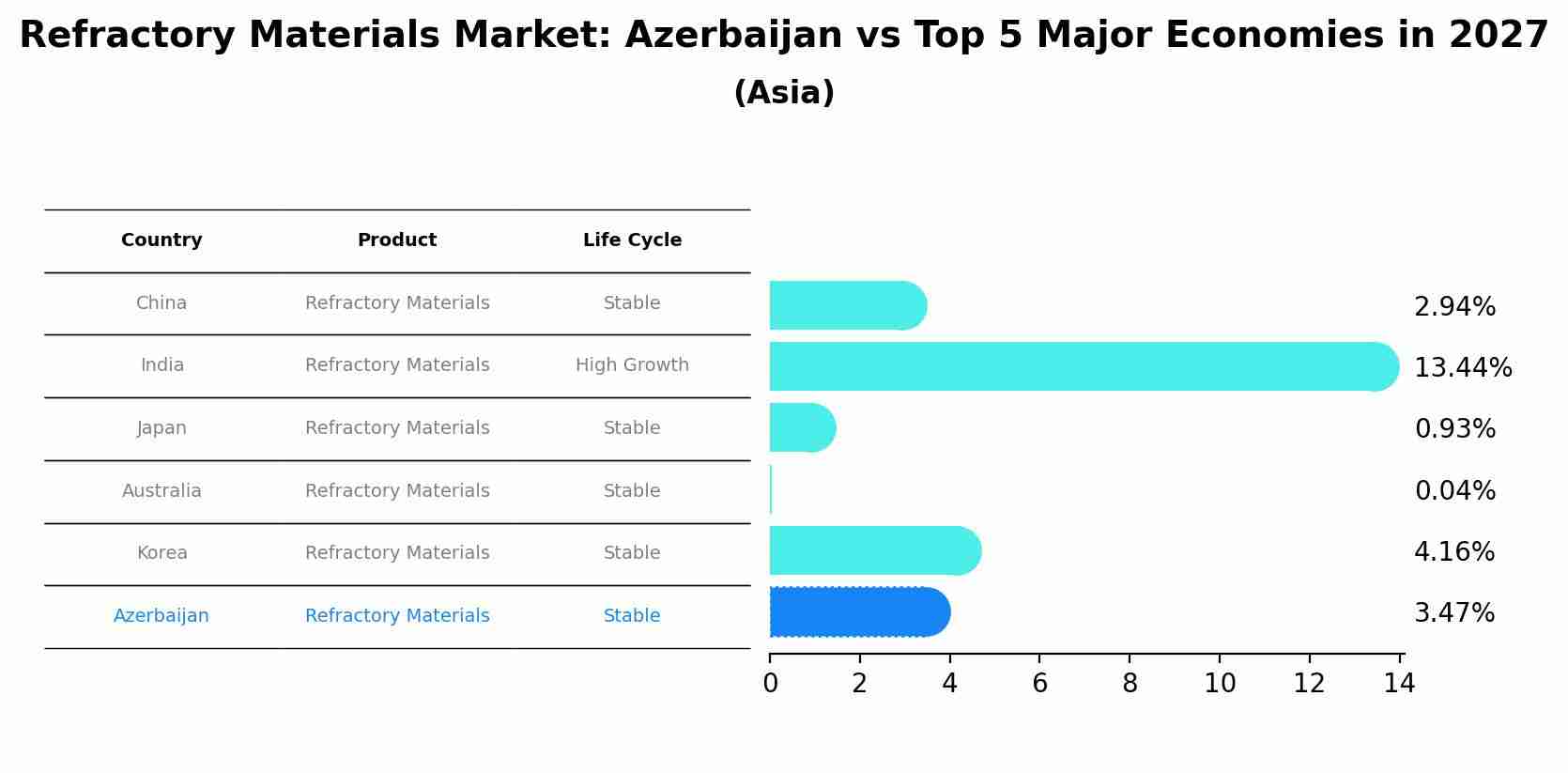Azerbaijan Refractory Materials Market (2025-2031) | Size, Outlook, Revenue, Growth, Analysis, Trends, Forecast, Share, Companies, Industry & Value
| Product Code: ETC033677 | Publication Date: Oct 2020 | Updated Date: Jun 2025 | Product Type: Report | |
| Publisher: 6Wresearch | Author: Shubham Deep | No. of Pages: 70 | No. of Figures: 35 | No. of Tables: 5 |
Azerbaijan Refractory Materials Market Size Growth Rate
The Azerbaijan Refractory Materials Market is projected to witness mixed growth rate patterns during 2025 to 2029. From 4.89% in 2025, the growth rate steadily ascends to 10.18% in 2029.

Refractory Materials Market: Azerbaijan vs Top 5 Major Economies in 2027 (Asia)
By 2027, Azerbaijan's Refractory Materials market is forecasted to achieve a stable growth rate of 3.47%, with China leading the Asia region, followed by India, Japan, Australia and South Korea.

Azerbaijan Refractory Materials Market Overview
The Azerbaijan refractory materials market is experiencing steady growth due to the country`s construction and industrial sectors. The market is driven by increasing demand for refractory materials in various industries such as steel, cement, glass, and ceramics. Key factors contributing to market growth include infrastructure development projects, increasing investments in industrial expansion, and a rise in demand for high-quality refractory products. Major players in the market are focusing on developing innovative products to meet the specific needs of industries, and there is a growing trend towards environmentally friendly and sustainable refractory materials. Overall, the Azerbaijan refractory materials market is poised for further growth with opportunities for new entrants and existing players to expand their market presence.
Azerbaijan Refractory Materials Market Trends
The Azerbaijan Refractory Materials Market is witnessing several key trends. Firstly, there is a growing demand for high-quality refractory materials in industries such as steel, cement, and glass due to increasing industrialization in the country. Additionally, there is a shift towards environmentally friendly and sustainable refractory materials to comply with stricter regulations and reduce carbon emissions. Another trend is the adoption of advanced technology in the manufacturing process to improve the quality and performance of refractory materials. Furthermore, the market is seeing increased competition among manufacturers, leading to innovations and development of new products to cater to diverse industry needs. Overall, the Azerbaijan Refractory Materials Market is evolving to meet the changing demands of industries while focusing on sustainability and innovation.
Azerbaijan Refractory Materials Market Challenges
In the Azerbaijan Refractory Materials Market, some of the key challenges include limited domestic production capacity, reliance on imports for raw materials, fluctuating global prices for key inputs such as alumina and silica, and competition from international suppliers. Additionally, the industry is affected by the overall economic conditions and political stability in the region, which can impact demand for refractory materials. There is also a need for technological advancements and innovation to meet the evolving requirements of industries such as steel, cement, and glass manufacturing. Furthermore, regulatory barriers and compliance with environmental standards pose challenges for companies operating in the market. Overall, addressing these challenges will require strategic planning, investment in R&D, and collaboration with international partners to enhance the competitiveness of the Azerbaijan refractory materials market.
Azerbaijan Refractory Materials Market Investment Opportunities
The Azerbaijan Refractory Materials Market presents promising investment opportunities due to the country`s growing industrial sector, particularly in the oil and gas industry. With ongoing infrastructure development projects and the presence of key players like OAO Azeraluminite and Ganja Refractories Plant, there is a demand for high-quality refractory materials for use in furnaces, kilns, and other high-temperature applications. Investing in the production or distribution of refractory materials in Azerbaijan can be lucrative, especially considering the country`s strategic location as a gateway between Europe and Asia. Additionally, the government`s focus on diversifying the economy and attracting foreign investment further enhances the potential for growth in the refractory materials sector in Azerbaijan.
Azerbaijan Refractory Materials Market Government Policy
The Azerbaijani government has implemented various policies to support the refractory materials market in the country. These policies include the promotion of domestic production to reduce dependency on imports, the provision of financial incentives and subsidies to local manufacturers, and the establishment of industry standards and regulations to ensure quality and safety. Additionally, the government has focused on fostering partnerships with international companies to enhance technology transfer and innovation in the sector. Overall, these policies aim to stimulate growth, improve competitiveness, and create a favorable business environment for the refractory materials market in Azerbaijan.
Azerbaijan Refractory Materials Market Future Outlook
The future outlook for the Azerbaijan Refractory Materials Market appears promising, driven by increasing industrialization, growing construction activities, and the expanding oil and gas sector in the country. The demand for refractory materials is expected to rise as these materials are essential for high-temperature applications in industries such as metal, glass, and cement production. Additionally, the government`s focus on infrastructure development and the ongoing investments in various sectors are likely to boost the demand for refractory materials. Market players are anticipated to invest in research and development to introduce innovative products with enhanced properties, catering to the evolving needs of the industries. Overall, the Azerbaijan Refractory Materials Market is poised for growth in the coming years, presenting opportunities for both domestic producers and international suppliers.
Key Highlights of the Report:
- Azerbaijan Refractory Materials Market Outlook
- Market Size of Azerbaijan Refractory Materials Market, 2024
- Forecast of Azerbaijan Refractory Materials Market, 2026
- Historical Data and Forecast of Azerbaijan Refractory Materials Revenues & Volume for the Period 2021 - 2031
- Azerbaijan Refractory Materials Market Trend Evolution
- Azerbaijan Refractory Materials Market Drivers and Challenges
- Azerbaijan Refractory Materials Price Trends
- Azerbaijan Refractory Materials Porter's Five Forces
- Azerbaijan Refractory Materials Industry Life Cycle
- Historical Data and Forecast of Azerbaijan Refractory Materials Market Revenues & Volume By Type for the Period 2021 - 2031
- Historical Data and Forecast of Azerbaijan Refractory Materials Market Revenues & Volume By Brick for the Period 2021 - 2031
- Historical Data and Forecast of Azerbaijan Refractory Materials Market Revenues & Volume By Monolithic for the Period 2021 - 2031
- Historical Data and Forecast of Azerbaijan Refractory Materials Market Revenues & Volume By Applications for the Period 2021 - 2031
- Historical Data and Forecast of Azerbaijan Refractory Materials Market Revenues & Volume By Clay Refractories for the Period 2021 - 2031
- Historical Data and Forecast of Azerbaijan Refractory Materials Market Revenues & Volume By Non-clay Refractories for the Period 2021 - 2031
- Azerbaijan Refractory Materials Import Export Trade Statistics
- Market Opportunity Assessment By Type
- Market Opportunity Assessment By Applications
- Azerbaijan Refractory Materials Top Companies Market Share
- Azerbaijan Refractory Materials Competitive Benchmarking By Technical and Operational Parameters
- Azerbaijan Refractory Materials Company Profiles
- Azerbaijan Refractory Materials Key Strategic Recommendations
Frequently Asked Questions About the Market Study (FAQs):
1 Executive Summary |
2 Introduction |
2.1 Key Highlights of the Report |
2.2 Report Description |
2.3 Market Scope & Segmentation |
2.4 Research Methodology |
2.5 Assumptions |
3 Azerbaijan Refractory Materials Market Overview |
3.1 Azerbaijan Country Macro Economic Indicators |
3.2 Azerbaijan Refractory Materials Market Revenues & Volume, 2019 & 2026F |
3.3 Azerbaijan Refractory Materials Market - Industry Life Cycle |
3.4 Azerbaijan Refractory Materials Market - Porter's Five Forces |
3.5 Azerbaijan Refractory Materials Market Revenues & Volume Share, By Type, 2021 & 2031F |
3.6 Azerbaijan Refractory Materials Market Revenues & Volume Share, By Applications, 2019 & 2026F |
4 Azerbaijan Refractory Materials Market Dynamics |
4.1 Impact Analysis |
4.2 Market Drivers |
4.3 Market Restraints |
5 Azerbaijan Refractory Materials Market Trends |
6 Azerbaijan Refractory Materials Market, By Types |
6.1 Azerbaijan Refractory Materials Market, By Type |
6.1.1 Overview and Analysis |
6.1.2 Azerbaijan Refractory Materials Market Revenues & Volume, By Type, 2016 - 2026F |
6.1.3 Azerbaijan Refractory Materials Market Revenues & Volume, By Brick, 2016 - 2026F |
6.1.4 Azerbaijan Refractory Materials Market Revenues & Volume, By Monolithic, 2016 - 2026F |
6.2 Azerbaijan Refractory Materials Market, By Applications |
6.2.1 Overview and Analysis |
6.2.2 Azerbaijan Refractory Materials Market Revenues & Volume, By Clay Refractories, 2016 - 2026F |
6.2.3 Azerbaijan Refractory Materials Market Revenues & Volume, By Non-clay Refractories, 2016 - 2026F |
7 Azerbaijan Refractory Materials Market Import-Export Trade Statistics |
7.1 Azerbaijan Refractory Materials Market Export to Major Countries |
7.2 Azerbaijan Refractory Materials Market Imports from Major Countries |
8 Azerbaijan Refractory Materials Market Key Performance Indicators |
9 Azerbaijan Refractory Materials Market - Opportunity Assessment |
9.1 Azerbaijan Refractory Materials Market Opportunity Assessment, By Type, 2019 & 2026F |
9.2 Azerbaijan Refractory Materials Market Opportunity Assessment, By Applications, 2019 & 2026F |
10 Azerbaijan Refractory Materials Market - Competitive Landscape |
10.1 Azerbaijan Refractory Materials Market Revenue Share, By Companies, 2024 |
10.2 Azerbaijan Refractory Materials Market Competitive Benchmarking, By Operating and Technical Parameters |
11 Company Profiles |
12 Recommendations |
13 Disclaimer |
- Single User License$ 1,995
- Department License$ 2,400
- Site License$ 3,120
- Global License$ 3,795
Search
Thought Leadership and Analyst Meet
Our Clients
Related Reports
- Germany Breakfast Food Market (2026-2032) | Industry, Share, Growth, Size, Companies, Value, Analysis, Revenue, Trends, Forecast & Outlook
- Australia Briquette Market (2025-2031) | Growth, Size, Revenue, Forecast, Analysis, Trends, Value, Share, Industry & Companies
- Vietnam System Integrator Market (2025-2031) | Size, Companies, Analysis, Industry, Value, Forecast, Growth, Trends, Revenue & Share
- ASEAN and Thailand Brain Health Supplements Market (2025-2031) | Strategy, Consumer Insights, Analysis, Investment Trends, Opportunities, Growth, Size, Share, Industry, Revenue, Segments, Value, Segmentation, Supply, Forecast, Restraints, Outlook, Competition, Drivers, Trends, Demand, Pricing Analysis, Competitive, Strategic Insights, Companies, Challenges
- ASEAN Bearings Market (2025-2031) | Strategy, Consumer Insights, Analysis, Investment Trends, Opportunities, Growth, Size, Share, Industry, Revenue, Segments, Value, Segmentation, Supply, Forecast, Restraints, Outlook, Competition, Drivers, Trends, Demand, Pricing Analysis, Competitive, Strategic Insights, Companies, Challenges
- Europe Flooring Market (2025-2031) | Outlook, Share, Industry, Trends, Forecast, Companies, Revenue, Size, Analysis, Growth & Value
- Saudi Arabia Manlift Market (2025-2031) | Outlook, Size, Growth, Trends, Companies, Industry, Revenue, Value, Share, Forecast & Analysis
- Uganda Excavator, Crane, and Wheel Loaders Market (2025-2031) | Strategy, Consumer Insights, Analysis, Investment Trends, Opportunities, Growth, Size, Share, Industry, Revenue, Segments, Value, Segmentation, Supply, Forecast, Restraints, Outlook, Competition, Drivers, Trends, Demand, Pricing Analysis, Competitive, Strategic Insights, Companies, Challenges
- Rwanda Excavator, Crane, and Wheel Loaders Market (2025-2031) | Strategy, Consumer Insights, Analysis, Investment Trends, Opportunities, Growth, Size, Share, Industry, Revenue, Segments, Value, Segmentation, Supply, Forecast, Restraints, Outlook, Competition, Drivers, Trends, Demand, Pricing Analysis, Competitive, Strategic Insights, Companies, Challenges
- Kenya Excavator, Crane, and Wheel Loaders Market (2025-2031) | Strategy, Consumer Insights, Analysis, Investment Trends, Opportunities, Growth, Size, Share, Industry, Revenue, Segments, Value, Segmentation, Supply, Forecast, Restraints, Outlook, Competition, Drivers, Trends, Demand, Pricing Analysis, Competitive, Strategic Insights, Companies, Challenges
Industry Events and Analyst Meet
Whitepaper
- Middle East & Africa Commercial Security Market Click here to view more.
- Middle East & Africa Fire Safety Systems & Equipment Market Click here to view more.
- GCC Drone Market Click here to view more.
- Middle East Lighting Fixture Market Click here to view more.
- GCC Physical & Perimeter Security Market Click here to view more.
6WResearch In News
- Doha a strategic location for EV manufacturing hub: IPA Qatar
- Demand for luxury TVs surging in the GCC, says Samsung
- Empowering Growth: The Thriving Journey of Bangladesh’s Cable Industry
- Demand for luxury TVs surging in the GCC, says Samsung
- Video call with a traditional healer? Once unthinkable, it’s now common in South Africa
- Intelligent Buildings To Smooth GCC’s Path To Net Zero


















